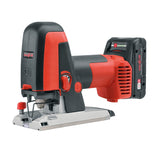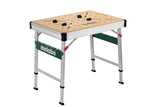This frame saw with a high performance Japanese universal saw blade makes fast and clean cuts along and across the grain. For rip cut, cross cut and diagonal cuts! The blade of this saw cannot be re-sharpened due to the impulse hardening process. It holds its sharpness for a long time. Japanese frame saw blades are thinner than Western blades, therefore they are more delicate.
This frame saw with a high performance Japanese universal saw blade makes fast and clean cuts along and across the grain. For rip cut, cross cut and diagonal cuts! The blade of this saw cannot be re-sharpened due to the impulse hardening process. It holds its sharpness for a long time. Japanese frame saw blades are thinner than Western blades, therefore they are more delicate. Avoid rough treatment!
Using a Japanese blade can substantially improve the quality of cut and general ease of use with frame saws. The saw teeth are laser hardened, which means they will remain sharp much longer than with conventional blades, but also means that they cannot be re-sharpened. Depending on how they are mounted, they can cut either on the push or pull stroke. If you hear or feel a light clattering while sawing, change the angle at which the blade enters the wood, which will help you to obtain a finer cut. Experiment with different blade angles, and you will be surprised at how much improvement you can expect in the speed and accuracy of the cut.
Japanese saw blades are thinner than the normal European types, and so a little bit more demanding. So be careful for instance to keep the blade lined up exactly in the cut. This will avoid kinking the blade. The listed lengths are for the total blade length! These blades fit easily into the saws from ECE and Ulmia, but not into the frames made by Wilhelm Putsch. If you would like anyway to use the Japanese blades in a Putsch frame, you will need to alter the mounting system using two of the blade holders listed near the bottom of the page, and you will also need to extend the middle beam a few millimeters or perhaps more simply make a new one.
The distance between the mounting holes in the same nominal length can be a few millimeters different. One must be aware of this when changing from a standard blade to a Japanese blade.
Wooden frame saws, also called bow saws, are built with two arms, with a bar or beam mortised into the center of the arms, forming an "H" shape. The saw blade is attached across the bottom of the H, and a tensioning system across the top. The beam mortised into the centers of the two arms provides the fulcrum around which the blade is tensioned. Because the blade is in tension, it can be significantly thinner than an ordinary hand saw blade, which must be relatively beefy so as not to buckle. Traditionally the tension was provided with several loops of hemp string in a Spanish windlass, but today it is more common to use a rod tightened with a wing nut at one or both ends.
Frame saws can be used for almost any job: cross cutting, rip sawing, crosscutting wet wood, cutting curves, and cutting shapes within a board. By cross cutting we mean cutting across the grain of a board to shorten it. Rip sawing is cutting along the grain to straighten or narrow a board. Because the blade of a frame saw is easy to release, one can drill a pilot hole, undo one end of the blade, put it through the hole, and then re-attach the blade and cut out almost any kind of shape inside the board, a long through mortise, for instance. Every task demands its own kind of blade for optimal performance. Rip cutting needs a blade with relatively large, flat filed teeth. Crosscut blades have finer teeth filed at an angle. The turning saw uses a narrow blade with fine teeth set for a wider kerf to enable it to cut curves. A big advantage of frame saws is that the blades are relatively long and so permit faster cutting than other types.
Many people enjoy building their own frame saws. They are fairly easy to make, and can be very inexpensive without sacrificing any quality relative to a manufactured product. A nice bonus is that one can give free reign to fantasy in the design and ornamentation of the saw. With a blade, a few bits of hardware, and wood from the scrap pile, one can also knock together a serviceable frame for a special job in a few minutes. But be careful: we have seen, for example, a saw built with thin, elegant arms and an even thinner center beam. Lovely saw, but the builder soon found that the frame was no where near stiff enough to offset the blade tension needed, and the arms were too thin in section to provide a good grip.
Universal saw blade, for rip, cross and diagonal cuts Specs.
Pitch 2 mm (13 TPI)
Blade thickness 0.6 mm
Kerf approx. 1.0 mm
Blade width 33 mm
Total length 600 mm
Distance hole center to hole center 570 mm
Teeth row length 545 mm
Diameter holes: 6 mm
Our warehouse is based in Nelson, New Zealand and all transactions are charged in New Zealand dollars. All shipping is charged at $NZD10 non rural and $NZD14 rural including GST for shipping anywhere within New Zealand excluding Great Barrier Island, Waiheke island, Chatham islands, d'Urville Island and Stewart Island.
All goods from a single order will be shipped together. If several orders have been made on the same day, by the same person, to the same delivery address, we will do our best to combine those orders into one shipment unless otherwise instructed.
Shipping is free of charge within New Zealand for all overs $450NZD excluding some Hikoki, Mafell, Tormek, Tanos, Metabo and Virutex. Free shipping is excluding Waiheke Island, Great Barrier Island, Chatham islands, d'Urville Island and Stewart Island.
Please contact us directly on sales@piranhatools.co.nz if you have any questions.
We Also Recommend








